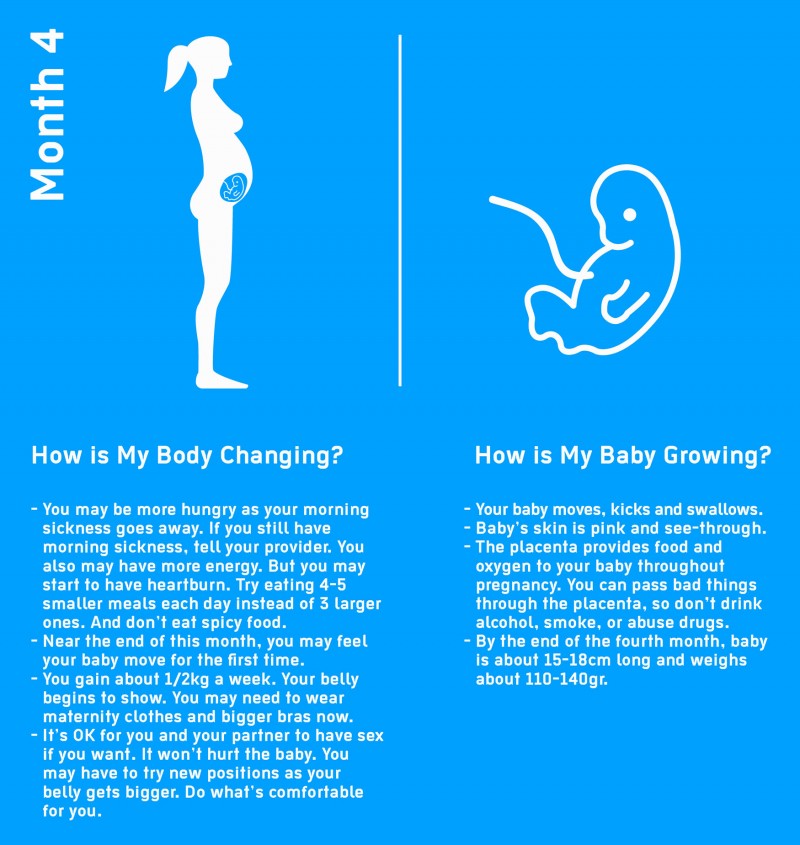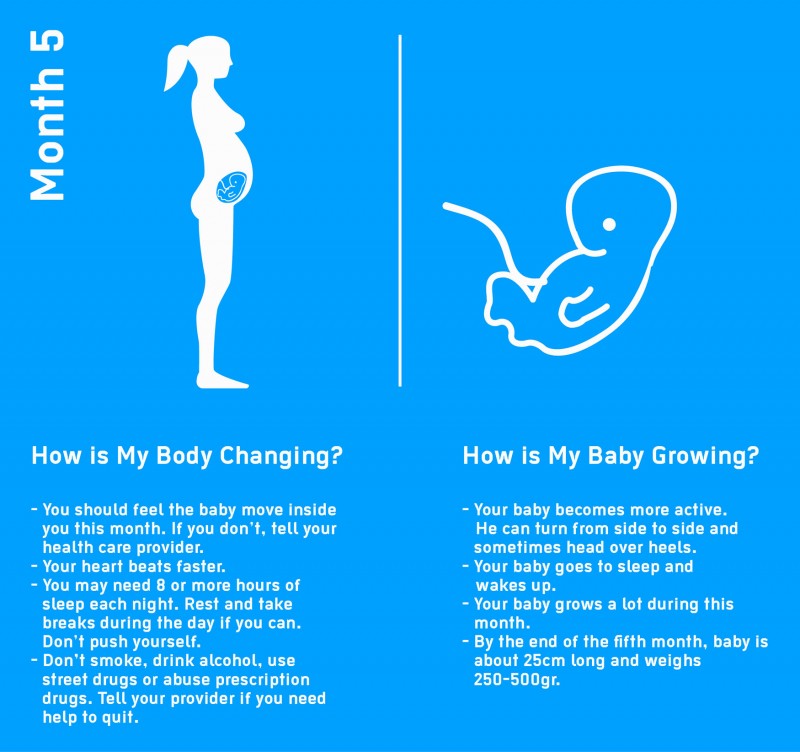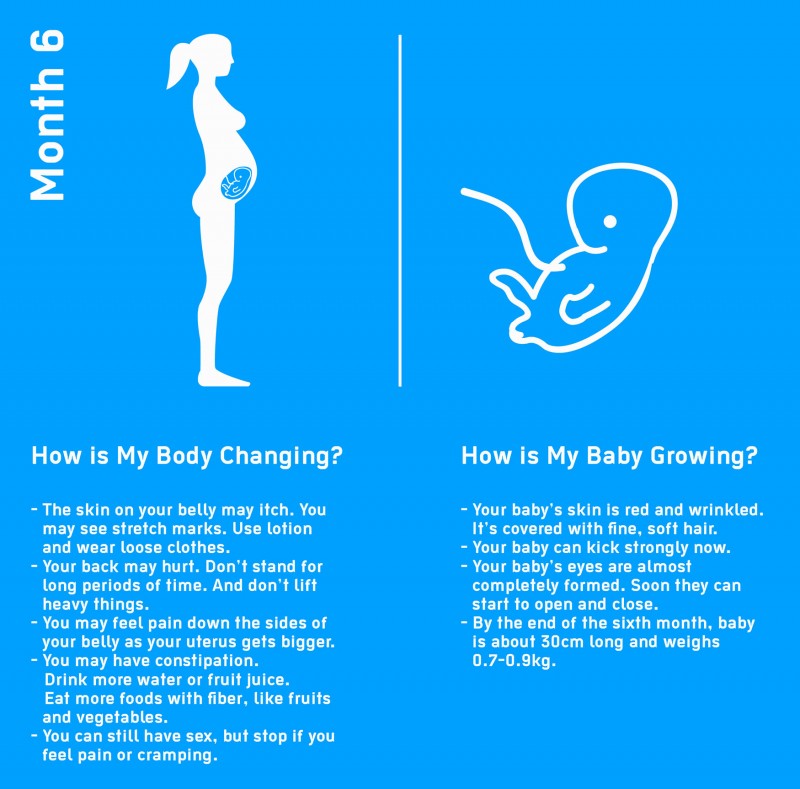Watch Inside Pregnancy weeks 15-20
How is my body changing and my baby growing?
Girl or boy: who decides?
By the 18th week of pregnancy, you should be able to tell if you are having a boy or a girl. The father’s sperm determines the sex of the child depending on if it is carrying an X or Y chromosome. The mother’s egg already contains an X chromosome, therefore the sex of a baby is determined by the X or Y chromosome of the father’s sperm. Studies show that your likelihood of having a boy or girl is inherited, meaning if the father has more brothers he is more likely to have sons, while if he has more sisters he is more likely to have daughters. There are lots of myths about things you can do to have a boy or girl; the position during sex (woman on top or lying on her side), the places you have sex, the time you have sex (odd days or evenings), or the foods you or your husband eat (salty foods, shellfish, etc). But there is no medical proof these work.
What are kegels and why do them?
Kegels strengthen your pelvic floor and help prevent or treat incontinence. It could also make sex more fun. If you haven’t already started doing them, you should start now. Here is a step-by-step guide:
- To help find the right muscles, imagine you are trying to stop urination midstream. It should feel like a "squeeze and lift". Be careful not to flex the muscles in your abdomen, thighs or buttocks and avoid holding your breath. It might be helpful to put your hand on your belly while doing kegels to ensure it stays relaxed.
- Squeeze for five seconds, and then relax for five seconds. Try it four or five times in a row.
- Don’t forget, it gets easier with practice so don’t worry if you have trouble isolating these muscles at first.
- Aim to increase the squeeze for 10 seconds at a time, relaxing for 10 seconds between contractions. You can also try squeezing as fast as you can for 10 seconds, resting 10 seconds and repeating a few times.
- You should aim for at least three sets of 10 repetitions a day. Do kegels with an empty bladder. You can do kegels discreetly almost anytime; sitting on a couch, at their desk or while in the car.
When will I feel my baby move?
The first time moms often feel the baby’s kick is at 18-20 weeks. Check with your doctor if you haven’t felt anything by 24 weeks.
If you have any of these danger signs, immediately contact your doctor or go to the hospital as they may indicate a major threat to you and/or your unborn child:
- Severe and/or constant abdominal pain.
- Vaginal bleeding, especially bright red blood.
- Severe, uncontrolled vomiting that causes dehydration.
- Headache, dizziness, or double vision or blurred vision for 2-3 hours.
- Chills and / or high temperature (38ºC or more).
- Sudden and severe swelling of the face and the hands and feet, and/or unexplained weight gain.
- Unusually slow or no movement of your baby after the sixth month.
Prenatal tests
You should visit your doctor at least two times during the second trimester. Whether or not you are asked, tell your doctor about all of your symptoms, even if they seem normal, like tiredness or aches and pains. Do not let your doctor rush through your appointment or make you think they are too busy. Yes, they may be busy, but your pregnancy is still the most important thing in the world to you.
The following is what you can expect from prenatal visits in the second trimester:
|
18-20 weeks:
|
- Health check with questions on problems or concerns since last visit, how you have been feeling, if you feel the baby move, if you have you been leaking fluid or bleeding. Doctor will measure your weight and blood pressure, and might check your urine if necessary.
- Counseling by the doctor on taking care of your health, warning signs, further tests to consider (e.g. further blood tests and/or an amniocentesis if you are at higher risk for genetic diseases), and changes to expect before your next visit.
- Ultrasound to check fetal development e.g. size, blood pressure, structural anomalies, placenta health.
|
|
25-28 weeks:
|
- Health check with questions on problems or concerns since last visit, how you have been feeling, how your baby is moving. Doctor will listen to baby’s heartbeat and measure your belly (if you doctor has an ultrasound, they will check baby’s development). Doctor will measure your weight and blood pressure.
- Counseling by the doctor on taking care of your health, warning signs, changes to expect before your next visit, keeping track of your baby’s daily movements.
- Lab tests to check blood (anemia, Rh antibodies, gestational diabetes test), urine (protein levels).
|
*The amount you see your doctor will depend on your medical history and if there are any complications that require more checkups. The WHO recommends a minimum of four prenatal visits around weeks 16, 24-28, 32, 36 for uncomplicated pregnancies. However in many countries, women go every month to the doctor, and every week during their last month of pregnancy.
^Together, the blood test and the ultrasound are known as the first-trimester combined screening, which provides a risk assessment of the fetus having Down syndrome as well as other chromosomal problems and birth defects. These tests are optional; you can agree or refuse to have them. These tests are not definitive, but provide a relative likelihood of the fetus having a genetic defect. There are two diagnostic tests that provide a certain result: 1) Chorionic villus sampling (CVS), done at 11-12 weeks; or 2) Amniocentesis, done at 16-20 weeks. These tests are invasive and carry a small risk of miscarriage, so they are typically only performed when the woman shows a higher risk for genetic and chromosomal problems. Your doctor will advise you if an invasive test is necessary, but again this test is optional and it is entirely your decision to have one or not.
What you need to know about C-sections
It is not a good idea to have a C-section, unless there is a legitimate medical reason e.g. labor complications like breech baby, or prior C-section. This is because C-sections can cause problems for you and your baby, especially in future pregnancies. Each C-section increases your risk for some serious complications in future pregnancies, which is why experts recommend a vaginal delivery if you intend to have several children. Be wary of doctors who push for C-sections without giving legitimate medical reasons, since C-sections often cost more for patients than vaginal births, and can be more convenient for doctors as they can be scheduled during ‘office hours’.
Some people think C-sections will be easier, less painful and less complicated, so it’s important to separate the myths from the realities.
Myth 1: Greater convenience. Yes, it can help you better plan for family help and work leave, but did you know you will:
- Not be able to schedule a C-section before 39 weeks so you must be ready if baby decides to come before that.
- Have added difficulty of recovering from major surgery while caring for a newborn and any other children.
- Be in the hospital for longer (an average of three days instead of one or two).
- Have to limit physical activity for several weeks.
- Have pain from your incision that can make it uncomfortable to breastfeed.
- Are significantly more like to return to hospital with complications.
Myth 2: Avoid pain of labor and delivery. Yes you not might not feel much pain during the surgery, but did you know you will:
- Likely have a longer, tougher recovery than most women with vaginal deliveries.
- Have pain in the weeks after delivery and will need medication.
- Have difficulty in picking up, caring for or feeding your newborn and other older children who might need extra attention given their new sibling.
- Likely still feel pain or discomfort during the process and after when the drugs wear off or give side-effects.
Myth 3: Minimize complications. Yes, you can avoid complications that happen in a small percentage of vaginal deliveries, but did you know that there are:
- Physical risks for the mother, both immediate and long-term. Since it is major surgery there are risks of complications such as infection, bleeding and injury to other organs. Once you have a C-section, you are more likely in future pregnancies to have a C-section, and this causes problems in future pregnancies such a placenta previa. The vast majority of tears that occur in vaginal births either cause little discomfort or may require stitches but usually heal well a short time.
- Psychological risks for the mother including negative feelings about the birth, and less early contact with her baby, which can harm bonding and breastfeeding and increase your risk for post-partum depression.
- Risks for the baby as Babies born by C-section may have more breathing and other medical problems.
Myth 4: Preserve ‘tightness’. Research has proven that long-term sexual function remains the same and is not impacted by vaginal birth. Vaginal tightness returns within six months post-partum after at least the first birth. You can do kegel exercises to tighten your vagina after a vaginal birth.
Category: Second trimester


